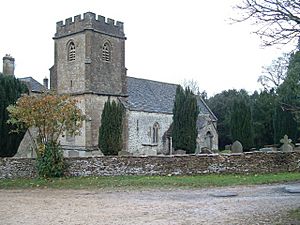Church of the Holy Rood, Daglingworth facts for kids
Quick facts for kids Church of the Holy Rood |
|
|---|---|
 |
|
| Lua error in Module:Location_map at line 420: attempt to index field 'wikibase' (a nil value). | |
| Denomination | Church of England |
| Architecture | |
| Heritage designation | Grade I listed building |
| Designated | 26 November 1958 |
| Administration | |
| Benefice | Ermin West |
| Diocese | Gloucester |
| Province | Canterbury |
The Church of the Holy Rood is an old church located in Daglingworth, a village in the Cotswold District of Gloucestershire, England. It's part of the Church of England. This church is very special because it was built a long, long time ago, in the 11th century! It's also a "Grade I listed building," which means it's a really important historical building that needs to be protected.
Contents
History of the Church
How the Church Grew Over Time
The Church of the Holy Rood was first built in the 11th century, which is over 900 years ago! Later, in the 15th century, parts of the church were made bigger. This included adding the church's tower.
Between 1845 and 1850, the church went through a big "restoration." This means it was repaired and updated. During this time, a new section called the north aisle was added. The chancel, which is the part of the church where the altar is, was also rebuilt.
Architecture and Special Features
What the Church Looks Like
The Church of the Holy Rood is made from limestone, a type of stone. Its roofs are covered with stone slates. The church has a main area called the nave, with a small entrance porch on the south side. It also has a chancel, a north aisle, and a tall tower on the west side.
The Church Tower and Bells
The church tower holds four bells. The oldest of these bells were made way back in 1720. Imagine how many times they've rung over the centuries!
Inside the church, there used to be a wall that divided the nave. Above this wall, there was a small room for the priest. However, this wall was removed in the 19th century. Today, you can see an organ placed above the chancel arch, which is the archway leading into the chancel.
Ancient Carvings and Art
During the rebuilding work in 1850, some amazing old carvings were found. These carvings are from the Saxon period, which means they are even older than the church itself! They were made around the year 1050, before the Norman Conquest of England. One of the most important carvings shows the crucifixion. These carvings follow an ancient style from Syria. They were originally part of the chancel arch but are now displayed in the nave.
Other Historic Items
The church also has an old altar that is in the Romanesque style. This style was popular in Europe from the 6th to the 11th century. This old altar is now used as a credence table, which is a small table used to hold things for the church service.
The font, where baptisms take place, is from the 15th century. It has a special carving of the Green Man, a mythical figure often seen in old art. The south porch, built in the 15th century, has a very old Saxon sundial. This sundial would have told people the time using the sun's shadow.
Outside in the churchyard, you can still see the remains of steps and a stone shaft from a medieval cross.

